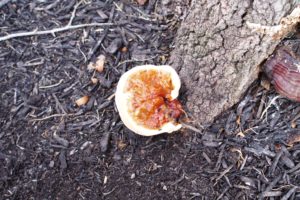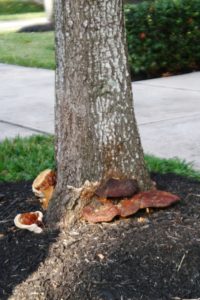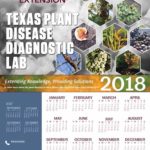
Ganoderma butt rot or root rot
Host: all types of wood – gymnosperms, woody dicots, palms. Maples, oaks and honeylocusts are particularly susceptible, although ashes, elms and many other deciduous trees and some conifers can be attacked.
SCIENTIFIC NAME of causal agent: Ganoderma spp. (G. zonatum, G. lucidum, G. applanatum)
DISEASE DESCRIPTION
SYMPTOMS:
Trees affected by this fungus may exhibit yellowing, wilting, or undersized leaves and dead branches, slower growth, and more dead lower leaves than normal. They are easily blow-down during rainstorms or windy periods. The advanced decay of the larger roots is evident after blow-down. Decay may extend from a few inches to several feet into the lower (butt) portion of the tree, depending on the species of Ganoderma involved.
BIOLOGY:
The fungus is spread by spores produced in the prominent fruiting bodies that form on the outside of the tree (conks). New spores released from the conks are easily dispersed by wind and water during humid periods, and infect open wounds on root and lower trunk areas of susceptible trees. The spores germinate, and the infection progresses to attack the sapwood of major roots and the lower tree trunk. Over the years, the amount of decayed wood increases leading to dangerously soft, spongy wood in the part of the tree that functions as its anchor. The conks are annual – new conks may be produced each summer and fall, after which they die and deteriorate.
MANAGEMENT METHODS:

No control is known for this type disease. Good cultural practices (planting, fertilizing, watering, pruning, etc.) will help to maintain the health and vigor of any tree. Avoid damage to tree trunks and roots. Even small wounds from mowers and trimmers can allow infection by decay fungi. Monitor trees and their stumps closely for the conks. . Once a conk is observed, the tree should be inspected, for safety reasons. Examinations shoud be done by a trained professional for structural integriry,
and if necessary the tree should be cut down. Remove as much of the stump and root system as possible. If you cannot remove the stump, then grind it up. Replace with different tree varieties that are not susceptible to Ganoderma spp.
RESOURCE LINKS:
Texas Plant Disease Handbook – Texas A&M Agrilife Extension https://plantdiseasehandbook.tamu.edu/landscaping/trees/maple/
Root and Butt Rot of Oaks- NCSU Plant Pathology Extension https://www.ces.ncsu.edu/depts/pp/notes/Ornamental/odin30/od30.htm
This factsheet is authored by Tram T. Le (Masters student)

Dr. Appel’s 2017 Fall PLPA601 students
Factsheet information for the plant health issues represented by the images on the 2018 TPDDL calendar were written by graduate students enrolled in the Department of Plant Pathology & Microbiology PLPA601 Introductory Plant Pathology course in the 2017 Fall semester (course instructor: Dr. David Appel). This exercise provides an opportunity for a high impact learning activity where the students are tasked with producing an informational output directed to the general public and to provide opportunity for the students to write.

CLICK HERE to return to 2018 TPDDL Calendar page